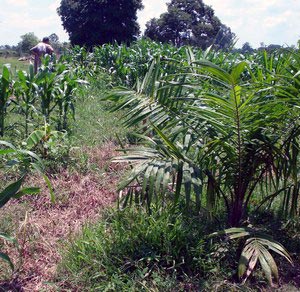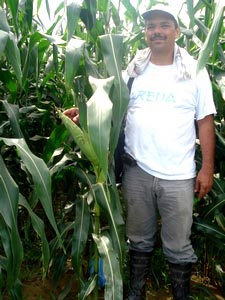
For about six years, CIMMYT and the large Colombian producer federations for coffee (FEDERECAFE) and cereals (FENALCE) have partnered to help coffee growers profit by cropping maize in the rows between pruned coffee plants, obtaining as many as three maize harvests while the coffee plants grow back.
Led by maize breeder Luis Narro, CIMMYT has contributed hybrids that yield as much as 10 tons per hectare and are resistant to locally-important fungal diseases, particularly those caused by Cercospora zeae-maydis and Phyllachora maydis. As one result, over the short life of this work the maize area in coffee zones has already gone from 5,000 to 60,000 hectares, with a potential of 150,000 hectares.
Moving to palms

This success has also bred a new partnership involving CIMMYT, FENALCE, and the Federation of Oil Palm Growers (FEDEPALMA). The plan is for palm plantations to grow three or four maize crops, while young palm plants complete their growth cycle. Oil palms are grown on 350,000 hectares in Colombia, though the potential is 10 times that area, according to Narro.
The palm-maize intercrop seems especially attractive, given that many Colombian plantations are completely renewing their oil palm stands due to severe attacks of bud rot disease (Phytophthora palmivora). This disease and other constraints are severely affecting small-scale (less than five hectares) palm growers in locations like Tumaco, who previously earned at least USD 1,500 per month selling palm for oil extraction. Critically, farmers’ production losses also represent lost employment for farm laborers, who are typically economically-disadvantaged. Growing maize offers a profitable hedge for all, while producers wait for the new generation of palm plants to come on line.
To date, 500 experimental maize hybrids have been tested in trials in 4 oil palm plantation zones. According to 90 farmers who took part in a field day at Tumaco in October 2009, the trial results have been good. The highest yields surpassed 10 tons per hectare, with yields of 7 tons and profits of USD 1,500 per hectare on small-scale farmers’ plots.
“An interesting advantage of this intercrop,” says Narro, “is that incorporating maize residues into fields makes the young palms mature to their productive stage in three years instead of four.”
For more information: Luis Narro, maize breeder (l.narro@cgiar.org)
 Capacity development
Capacity development 
